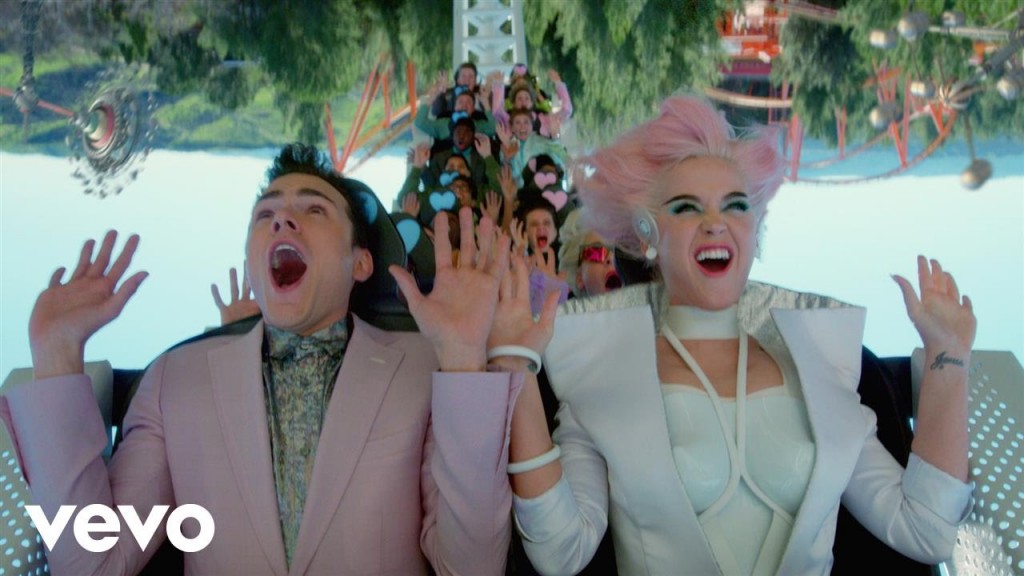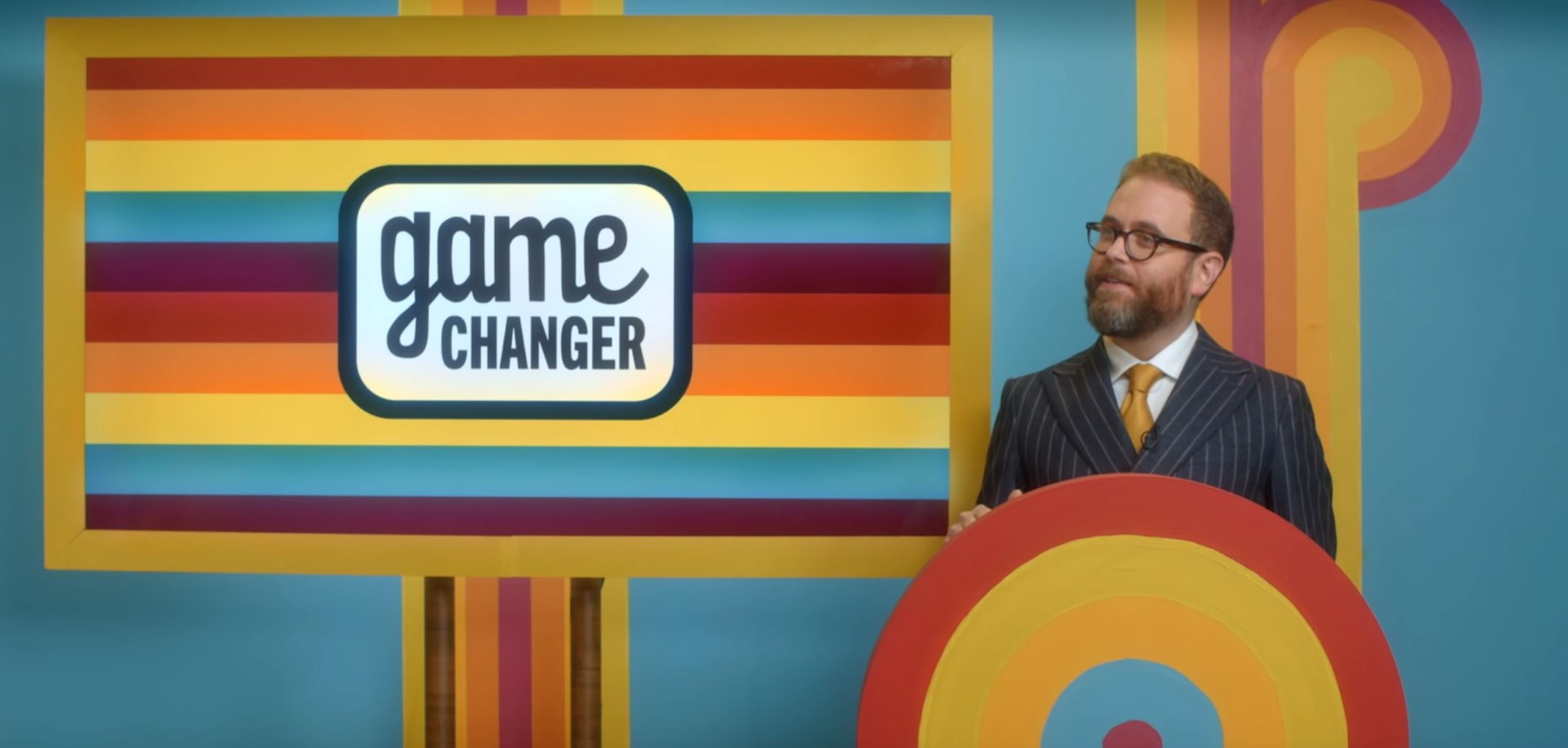
The pop diva’s latest release is packed with social commentary
By Carlos Bilan, Staff Writer
Katy Perry has recently released her first lead single since her previous album, Prism, came out in 2013. “Chained to the Rhythm” is the pop diva’s most thought-provoking release to date. The song, co-written with Sia, and the music video, directed by Mathew Cullen, both deliver innuendos relevant in today’s society.
The music video takes place in a futuristic amusement park called Oblivia, a utopian wonderland filled with high-tech rides. The name itself is already a hint of the video’s setting, a portmanteau of “oblivious” and “utopia” where everything seems perfect, but actually isn’t. Perry enters Oblivia donning pink hair and a futuristic look as she marvels at the park’s beauty, and as Perry walks around, the hints of symbolism start pouring. The first is the scene where three people are seen glued to their tablets as they walk into the park and pose for selfies in synchronisation, which coincides with the line “So comfortable we’re living in a bubble/So comfortable we cannot see the trouble.” This shows how people nowadays are so addicted to social media that they miss what’s happening in their surroundings.
The first ride introduced is called The Great American Dream Drop, which consists of suburban-style houses getting suspended in the air and spun around like swings. A couple enters a house excited for the ride as they settle in the house as if it was their home. The houses eventually drop jarringly, possibly a metaphor for when the housing market crashed in the US.
In a different scene, Perry is seen smelling the roses, but when she touches a stem she gets pricked, which can suggest how looks can be deceiving and how nothing is perfect. Later, she takes a ride on a rollercoaster where riders must be paired with a seatmate of the opposite sex—blue heart seat for boys on one seat, and pink for the girls on the other. It is even important to note how Perry’s seatmate is a boy who appears flamboyant and is dressed in a pink suit. This is symbolic of heteronormativity, and how same-sex relationships are not seen as a norm in many societies. The ride, called Love Me, enters a tunnel filled with Facebook reaction emoticons. After the ride, Perry and her seatmate Simon are scored at the “validation station,” which is a nod to how many people seek validation for the activities they do through social media. Perry receives a “17” while Simon receives “9,748,” which can also be a nod to the gender pay gap, a persistent problem where men get paid more than women even when they do the same job.
A scene is shown where people are queuing for a ride and the wait time shows “1984 HR” which is a reference to George Orwell’s dystopian novel 1984. Perry said in an interview that the name of the hamster in the lyric video and on the insignia of Oblivia is “Mr. Parsons,” a character from the novel who presents the ideal citizen, unquestioning of the government and the system.
In the next scene, Perry is shown walking along a massive white picket fence and seeing a ride called No Place Like Home, where riders are catapulted over the fence. An important detail is the people Perry sees being catapulted are people of colour, so this is a metaphor of the ongoing wall Trump and his supporters want to build at the US/Mexican border and the xenophobic rhetoric about the wall. This scene coincides with the lyrics Perry sings as she hopes that as a society “we can do better than that.”
The next ride called Bombs Away shows nuclear warheads and the following frame depicts a stick of cotton candy shaped like a mushroom cloud. It is an unsettling reference to a threat of nuclear warfare linking the 1950s aesthetic of the video with the Cold War that was ongoing in that era.
The hamster wheel is a ride that seems to be the centrepiece of Oblivia, based on its long queue. Like the endless spinning of the wheel, it can represent the status quo. It’s significant to note that the people who struggle running on the wheel are people of colour, which suggests, as they tumble down, how it can be unsustainable for them.
The penultimate park attraction is not a ride but a gas station called Oblivia H20 that serves flammable water. This may be a reference to oil, which, like water, is an important commodity to the global economy. It may also allude to hydraulic fracturing and the construction of pipeline can create for nearby inhabitants, since water can become flammable. This might be Perry’s political stance in opposing the Dakota Access Pipeline.
The last attraction is not a ride as well, but rather a 3-D viewing of Nuclear Family, a movie which features a father reading a newspaper, a mother ironing clothes, and a daughter drawing a picture. This shows society’s view of the traditional family, where the father works and the mother stays at home, which ties into gender roles.
As everyone is wearing their 3-D glasses and bopping their heads along with the beat, Perry seems to be the only one who notices Skip Marley appear on the screen. His lyrics are significant, especially since he suggests a revolution and creating change in society. Perry takes off her glasses, stands up, walks to the front, and takes Marley’s hand. This can be symbolic of Perry participating in this cause, but also of Perry’s character opening her eyes to what’s happening.
Towards the end, Perry is singing in the middle of a crowd that circles her, and she seems to be gesturing a wakeup call, but they all continue to move around in a choreographed fashion. This may be representative of how everybody is chained to the rhythm and how “it goes on and on and on,” like the metaphor of the hamster wheel: A scene is interspersed with Perry running successfully on the hamster wheel, showing her privilege, but she quickly halts after this realization.
Looking at her discography, Katy Perry may not be expected to release a socially and politically relevant music video. However, Perry has been a vocal endorser of Hillary Clinton during the elections, and she took part in the Women’s March. “Chained to the Rhythm” is the songstress’ reaction to the heartbreak many of us felt in the election season, and her video breaks the mould with its social message.


